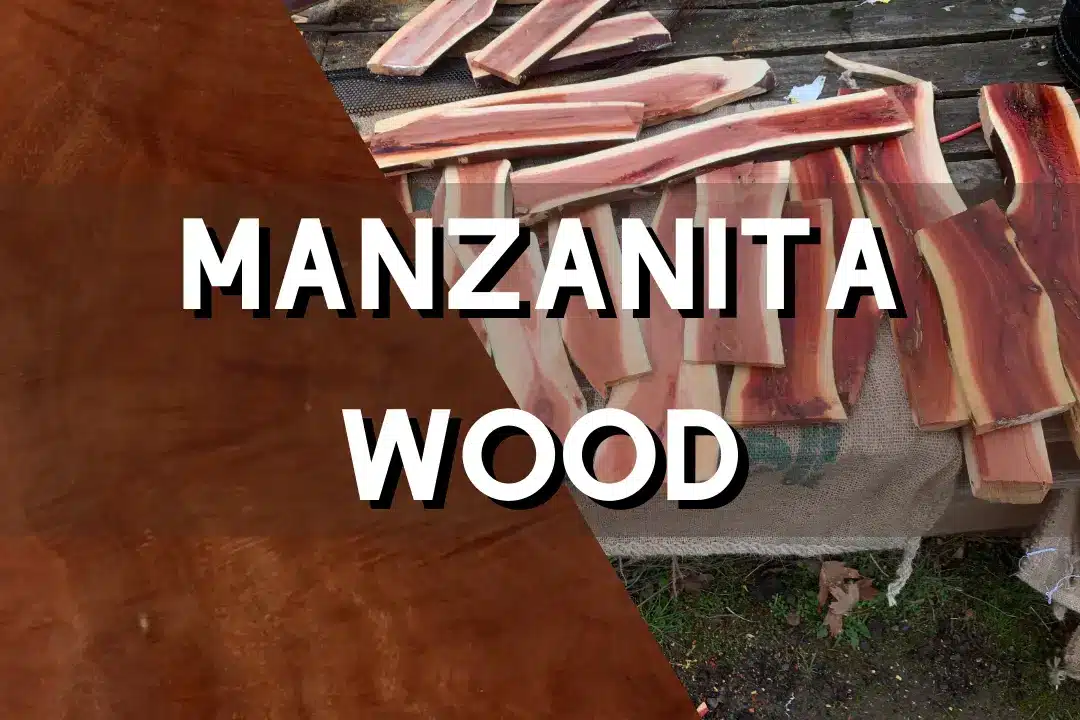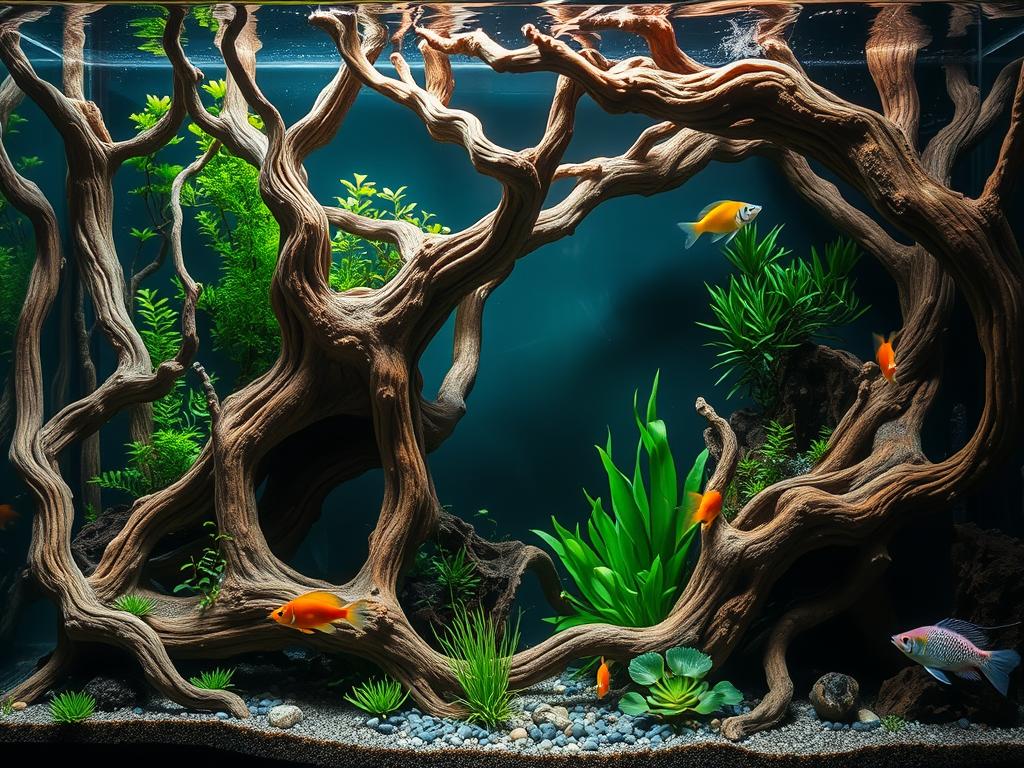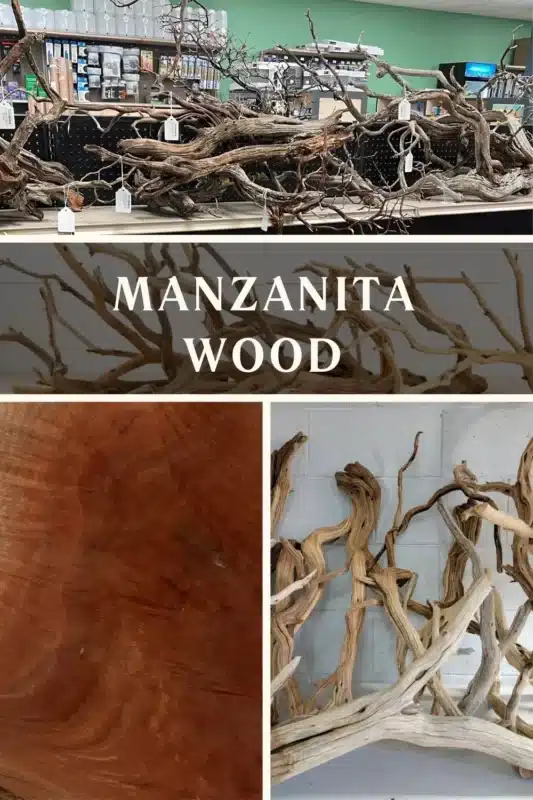
Manzanita Wood: The Best Choice for Decorative Pieces.

Did you know manzanita wood is great for aquariums because it has low moisture and tannin? This makes it perfect for water environments and adds beauty to decorations. Its unique look and strong build make any project stand out.
This article dives into what makes manzanita wood special. It shows why it’s the top pick for decorations. With its rich textures and many uses, it brings beauty and function together. See why so many people love working with this wood.
Table of Contents
What is Manzanita Wood?
Manzanita wood comes from the Arctostaphylos pungens shrub. This plant is found in western North America’s shrublands. It has gnarled branches and grows 3 to 16 feet tall.
The wood is known for its rich, warm tones. These tones make it popular for decoration.
This unique branch wood is not just about looks. It’s rare, taking centuries to be ready. There are over 105 types of Arctostaphylos shrubs. As the wood ages, it turns from light to a unique “Manzanita Red.”
This wood is strong and lasts long. It’s great for both decoration and practical uses. Its popularity is growing among craftspeople and decorators.
| Property | Description |
|---|---|
| Wood Origin | Derived from the shrub Arctostaphylos pungens |
| Typical Height | 3 to 16 feet |
| Color Change | From light whitish to “Manzanita Red” |
| Species Variety | Over 105 species and subspecies |
| Growth Time | Centuries to produce usable pieces |
Characteristics of Manzanita Wood
Manzanita wood has unique qualities that make it special. Its beauty and durability are why it’s loved in crafts and decor.
Color and Appearance
The wood’s heartwood is a beautiful brownish-red color. It also has bright orange undertones. The sapwood is a pale off-white to light brown, making it stand out.
This color range adds beauty to any item made from it. It makes them eye-catching in any room.
Texture and Grain
The texture of manzanita wood is fine and even. It has a natural shine. The grain patterns are unique, with burls and swirls.
These patterns make each piece special. They’re perfect for those who love unique items.
Density and Weight
This twisted hardwood is very dense, weighing about 57.6 lbs/ft³. This makes it very durable. It’s also very hard, with a Janka rating of 2,350 lbf.
This hardness means it can handle a lot of wear. It’s great for both looks and function.
| Characteristic | Details |
|---|---|
| Heartwood Color | Brownish-red with bright orange undertones |
| Texture | Fine, uniform, and naturally lustrous |
| Grain Pattern | Unique burls and swirls |
| Density | Averages 57.6 lbs/ft³ |
| Weight | High, contributing to durability |
| Janka Hardness Rating | 2,350 lbf |
Durability and Rot Resistance
Manzanita wood is known for its long-lasting quality and resistance to rot. Though there’s little official data, many stories show it can handle different environments. This makes it great for both looks and practical uses.
Anecdotal Evidence of Durability
Many people have found manzanita wood to be very durable indoors and outdoors. It’s one of the hardest driftwoods, with a Janka hardness rating of 2,350 lbf. This means it can make beautiful, lasting pieces.
Its design and density also help it last for years. This wood stays strong and beautiful over time.
Conditions Affecting Longevity
How long manzanita wood lasts depends on things like humidity and water exposure. Keeping it dry helps it last longer and resist rot. It’s important to treat the wood well before using it.
Soaking or boiling the wood can help remove tannins. This keeps it looking good and helps it sink in water. With the right care, manzanita wood looks great and works well in any place.
Manzanita Wood: The Best Choice for Decorative Pieces
Manzanita wood is a standout in decorative items because of its beautiful look and strong build. It comes in colors from deep reddish-browns to light, sun-kissed hues. This makes it perfect for many design styles. People who make and decorate spaces love the beauty manzanita wood brings.
This unique branch wood is more than just pretty. It’s very dense and hard, lasting a long time. This means any item made from it will look great for years. Also, it’s safe for aquariums because it doesn’t harm the water.
Manzanita wood is also great for making things because of its size and weight. It’s usually 3-16 feet tall and 6-10 inches wide. After it’s cut, it’s sanded to make it even more beautiful.
There’s a lot of talk about manzanita wood online. People love its beauty and usefulness. It brings a natural elegance to any space.
Common Uses of Manzanita Wood
Manzanita wood is very versatile, making it a favorite for many uses. It’s known for its unique look and durability. This wood is used in crafting and even in aquariums.
Decorative Items
In crafting, manzanita wood stands out for its beauty. Artists use it to make sculptures, wall art, and furniture. The wood’s rich colors add elegance to any room.
The wood’s strength and durability mean these pieces last a long time. They stay beautiful for years.
Functional Items in Aquariums
This unique branch wood is also great for aquariums. It’s perfect for creating hiding spots for fish. This helps keep them healthy and happy.
The wood’s strength supports the underwater world. It’s perfect for enhancing any aquarium. Its natural beauty and resistance to rot help create a thriving environment.
Manzanita Wood in Aquariums
Adding manzanita wood to aquariums has many benefits. It makes the tank look better and helps keep the water clean. This wood is good for fish and other sea creatures.
Benefits for Aquatic Environments
Manzanita wood helps fish feel less stressed and keeps the water quality high. It doesn’t change the water color as much as other woods. This wood creates a safe space for fish, like rainbow cichlids, to breed.
It lasts a long time in water, over 11 years, which makes it popular among aquarium fans.
Preparing Manzanita Wood for Aquarium Use
To use this reddish decorative wood in an aquarium, you need to prepare it first. Start by sanding and soaking the wood for 4-7 days. This makes it ready for water.
Soaking helps lower the amount of tannins released. But, some color might still come out after a while. You might need to change the water often if the wood releases a lot of tannins.
| Characteristic | Details |
|---|---|
| Diameter | Up to 2 inches |
| Length | 15 to 21 inches |
| Longevity | Over 11 years submerged |
| Tannin Levels | Lower than Mopani or Bog Wood |
| Soaking Time | 4-7 days to waterlog |

Collecting and Sourcing
Collecting manzanita wood requires you to know the legal rules. Many places let you take dead wood for personal use. But, it’s key to check the local laws first. Some areas might have rules or need a permit for collecting natural stuff.
Knowing these rules helps make sure you’re collecting wood the right way. It also helps protect the environment.
Legal Considerations for Collecting
Before you start collecting manzanita wood, it’s important to learn the legal rules. In state parks or protected places, you might need a permit. These places have rules to protect the native plants and animals.
It’s good to know the local laws about collecting natural things. This way, you can collect wood responsibly.
Where to Buy Manzanita Wood
If you want to buy manzanita wood, there are many places to look. Specialty wood stores and online shops have what you need. They sell root burls and turning blanks.
This dense shrubby wood is rare, so it can be pricey. But, it’s worth it for its beauty. Look for trusted sellers who promise quality wood.
| Retail Source | Product Offered | Estimated Price Range |
|---|---|---|
| Local Specialty Wood Store | Root Burls | $30 – $100 |
| Online Retailer A | Turning Blanks | $15 – $60 |
| Online Retailer B | Whole Logs | $50 – $150 |
Working with Manzanita Wood
Working with manzanita wood comes with its own set of challenges. The wood’s dense structure and irregular grain patterns make machining tough. Knowing these challenges helps both hobbyists and professionals get good results.
Machining Challenges
Machining this reddish decorative wood requires careful attention. Small pieces usually work well, but larger or more gnarled ones need extra care to avoid fractures. The wood’s varying density can also affect the cutting tool’s performance.
It’s important to use sharp blades made for tough hardwoods for clean cuts. The right machinery settings depend on the piece’s characteristics.
Finishing Techniques
Finishing this dense shrubby wood can lead to stunning results. Techniques like sanding, sealing, and oiling enhance the wood’s natural shine and protect it. Use fine-grit sandpaper to smooth the surface without harming the grain patterns.
After preparing the wood, apply sealants or oils to deepen the color and finish. Choosing the right treatment techniques ensures the finished product stays beautiful over time.

Cost and Availability
The price of manzanita wood can change a lot. This is because of many factors. Shapes, sizes, and how the wood is prepared all play a part. Since it’s not easy to find, this dense shrub wood is often more expensive than other types.
Factors Influencing Price
Several things affect how much manzanita wood costs:
- Shape and Size: Pieces that are unique or big cost more.
- Sourcing Locations: Where the wood comes from can change the price.
- Processing Needs: The cost of cutting and finishing adds up.
Sustainability of Sourcing Practices
Manzanita wood is good for the environment. It’s not in danger, and picking deadwood is okay. This way, the wood can be used without harming nature.
Using this twisted hardwood helps forests get better. It helps a species that might be lost for bigger trees. This helps keep nature balanced and supports life where manzanita grows.
| Factor | Description |
|---|---|
| Shape and Size | Unique shapes and larger sizes increase manzanita cost. |
| Sourcing Locations | Regional availability affects pricing, depending on accessibility. |
| Processing Needs | Additional costs for cutting, finishing, and preparing for sale. |
| Sustainability | Responsible sourcing practices support ecosystem health. |
Comparison with Other Woods for Decoration
Looking at materials for decorative items, manzanita wood shines. It has unique qualities and looks great. Its high density means it’s very durable, better than many hardwoods.
Manzanita vs. Other Hardwoods
Many hardwoods are used for decoration, each with its own traits. Let’s see how manzanita wood compares to some favorites:
| Wood Type | Moisture Resistance | Durability | Unique Qualities |
|---|---|---|---|
| Manzanita Wood | Excellent | High | Gnarled structure and rich coloring |
| Mopani Wood | Good | High | Dense and sinks well |
| Spiderwood | Moderate | Shorter lifespan | Softwood, easier to shape |
| Cork Bark | Excellent | Highly durable | Almost completely moisture resistant |
| Ghostwood | Good | Moderate | Darkens with humidity |
Unique Qualities
This twisted hardwood is special for decoration. Its gnarled look makes it look like a tree. It also looks good with different finishes. These qualities make it a top pick for wood lovers, different from other hardwoods.
Expert Tips for Using Manzanita Wood
Learning the best ways to care for manzanita wood and its artistic uses can really boost your projects. With the right care and creative ideas, you can fully enjoy this unique and beautiful material in your decor.
Care and Maintenance
Keeping manzanita wood looking great needs regular care. Make sure to wipe off dust often to keep it clean. Use oil or a finish to protect the wood, keeping its color bright and preventing it from drying out.
Setting up a routine for manzanita wood care will help it last longer. It will also keep it looking amazing in your home.
Creative Decorative Uses
Manzanita wood is perfect for many creative projects. You can use it for eye-catching centerpieces, unique wall art, or even furniture pieces. Each piece made from manzanita wood highlights its natural beauty, offering endless ways to express your creativity.
The creative uses for this twisted hardwood not only make your space look better. They also add a warm, organic feel to any room.
| Maintenance Tips | Creative Uses |
|---|---|
| Regularly dust surfaces | Use in centerpieces for events |
| Apply finish to maintain color | Create wall art with unique shapes |
| Store in a dry place to prevent damage | Design furniture with a natural look |
| Avoid direct sunlight to prevent fading | Incorporate in decorative displays |
Conclusion
Manzanita wood is a top pick for decorative uses because of its beautiful look and lasting quality. Its red-brown color and special patterns make it a favorite among artists and woodworkers. It adds a unique charm to any place.
This wood is not just pretty; it’s also tough. Its density and hardness help it stand up to wear and tear. This makes it great for making beautiful items like bowls, furniture, and decorations.
Using manzanita also helps the environment. Since it grows back after wildfires, it’s a sustainable choice. More people want eco-friendly options, and manzanita wood meets that need while still being beautiful.
In short, manzanita wood is perfect for making an aquarium look better or adding style to a home. Its rich history and modern uses make it a favorite among many. It’s a wood that people love and use for their crafts.
FAQs
What makes manzanita wood a popular choice for decorative pieces?
Manzanita is loved for its unique look. It has rich colors and detailed grain patterns. It’s also durable and fits well in many styles.
Can manzanita wood be used in aquariums?
Yes, it’s great for aquariums as driftwood. It gives fish places to hide and makes the tank look natural.
How should I prepare manzanita wood for aquarium use?
Clean and soak the wood before putting it in your tank. Sand it to make sure it’s safe for water.
What is the difference between heartwood and sapwood in manzanita wood?
Heartwood is brownish-red with orange undertones. Sapwood is off-white to light brown. This contrast makes the wood look even more beautiful.
Is manzanita wood resistant to decay?
People say it’s very durable. It can handle both indoor and outdoor conditions well.
What factors influence the price of manzanita wood?
Prices depend on availability, size, and how it’s processed. Its unique look can also make it more expensive.
Can I collect manzanita wood myself?
Yes, you can collect dead wood in many places. But always check local laws first. Some areas need permits.
Where to buy manzanita wood?
You can find it at specialty stores or online. They often sell root burls and small turning blanks.





